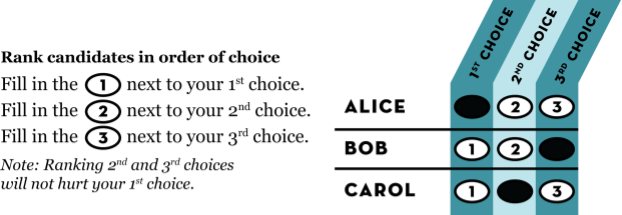In Ranked-Choice Voting, voters rank as many candidates as they want in order of preference. If any candidate has a majority (more than half) of the first-preference votes, then that candidate is elected. Otherwise, the RCV process builds a majority by eliminating the candidate with the lowest number of votes and transferring votes cast for the eliminated candidate to the voters’ next preference, repeating the process until one candidate has a majority of the votes.
Marking the Ballot
For voters, RCV is literally as easy as 1, 2, 3. Just rank your choices in order of preference. This sample ballot shows a voter who preferred Alice first, Carol second, and Bob third. Voters may rank all, or just some, of the candidates.

Counting the Votes
RCV ballots are counted in a series of rounds, as shown in the flowchart below. First, all the first choices are counted. If any candidate has a majority (50% +1) of the votes, that candidate wins. Otherwise, the last-place candidate (the candidate with the fewest number of votes) is eliminated, and any votes cast for that candidate are transferred to the voter’s next preference (if the voter chose to rank more candidates). If there is no candidate with more than half of the votes, another candidate is eliminated, and there is another round of counting. The process is repeated as often as needed to ensure that one candidate has more than half of the votes. In this way, RCV eliminates the “spoiler effect” and ensures that the winning candidate is preferred by at least 50% of the voters.

Counting Multi-Winner Races
Ranked Choice Voting can also be used to elect multiple candidates at a time. For more details, check out this multi-winner RCV example provided by our friends at FairVote.
Try it Out!
To see how Ranked Choice Voting works, try out a sample election and vote for your favorite Super Bowl Snacks!
Do you like this page?
